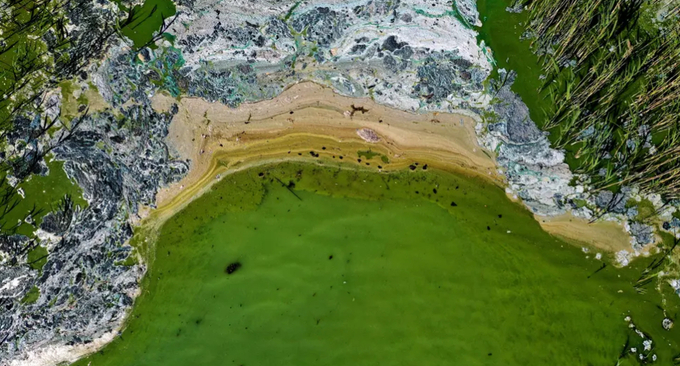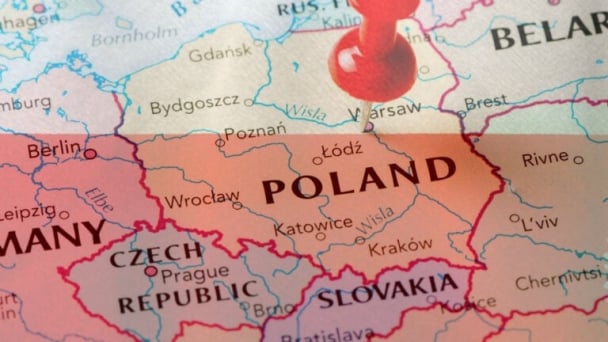June 21, 2025 | 02:59 GMT +7
June 21, 2025 | 02:59 GMT +7
Hotline: 0913.378.918
June 21, 2025 | 02:59 GMT +7
Hotline: 0913.378.918

The overuse of phosphorus is creating algal blooms such as the one in the Baltic Sea near Stockholm in Sweden. Photo: TT News Agency
Our planet faces “phosphogeddon”, scientists have warned. They fear our misuse of phosphorus could lead to deadly shortages of fertilisers that would disrupt global food production.
At the same time, phosphate fertiliser washed from fields – together with sewage inputs into rivers, lakes and seas – is giving rise to widespread algal blooms and creating aquatic dead zones that threaten fish stocks.
In addition, overuse of the element is increasing releases of methane across the planet, adding to global heating and the climate crisis caused by carbon emissions, researchers have warned.
“We have reached a critical turning point,” said Prof Phil Haygarth of Lancaster University. “We might be able to turn back but we have really got to pull ourselves together and be an awful lot smarter in the way we use phosphorus. If we don’t, we face a calamity that we have termed ‘phosphogeddon’.”
Phosphorus was discovered in 1669 by the German scientist Hennig Brandt, who isolated it from urine, and it has since been shown to be essential to life. Bones and teeth are largely made of the mineral calcium phosphate – a compound derived from it – while the element also provides DNA with its sugar phosphate backbone.
“To put it simply, there is no life on Earth without phosphorus,” exlpained Prof Penny Johnes of Bristol University.
The element’s global importance lies in its use to help crop growth. About 50m tonnes of phosphate fertiliser are sold around the world every year, and these supplies play a crucial role in feeding the planet’s 8 billion inhabitants.
However, significant deposits of phosphorus are found in only a few countries: Morocco and western Sahara have the largest amount, China the second biggest deposit and Algeria the third. In contrast, reserves in the US are down to 1% of previous levels, while Britain has always had to rely on imports. “Traditional rock phosphate reserves are relatively rare and have become depleted in line with their extraction for fertiliser production,” added Johnes.
This growing strain on stocks has raised fears the world will reach “peak phosphorus” in a few years. Supplies will then decline, leaving many nations struggling to obtain enough to feed their people.
The prospect concerns many analysts, who worry that a few cartels could soon control most of the world’s supplies and leave the west highly vulnerable to soaring prices. The result would be the phosphate equivalent of the oil crisis of the 1970s.
The predicament was once summed up by the science fiction writer Isaac Asimov: “Life can multiply until all the phosphorus is gone and then there is an inexorable halt which nothing can prevent.”
These dangers were also highlighted last week with the publication in the US of The Devil’s Element: Phosphorus and a World Out of Balance, by the environment writer Dan Egan. The book has yet to be published in the UK but it mirrors concerns recently raised by British scientists.
They say we have become profligate in the use of phosphates we put on our fields. Fertiliser washed from them – and discharges of phosphorus-rich effluent – have triggered large-scale contamination of water and created harmful algal blooms. Some of the world’s biggest bodies of freshwater are now afflicted, including Russia’s Lake Baikal, Lake Victoria in Africa and North America’s Lake Erie. Blooms at Erie have led to poisoning of local drinking water in recent years.
“Just as they do on land, phosphates help aquatic plants to grow,” said Haygarth, who is the co-author of Phosphorus: Past and Future. “And that is now having calamitous consequences in rivers, lakes and seas.”Choked by blooms, many of these bodies of water have become dead zones, where few creatures survive and which are expanding. One dead zone now forms in the Gulf of Mexico every summer, for example.
Such crises also create other environmental problems. “Climate change means we will get more algal blooms per unit of phosphate pollution because of the warmer conditions,” said Prof Bryan Spears of the UK Centre for Ecology & Hydrology in Midlothian.
“The problem is that when that algae dies, it can decay to produce methane. So a rise in blooms will mean more methane will be pumped into the atmosphere – and methane is 80 times more potent than carbon dioxide at warming the atmosphere. It is a cause for real concern.” Spears led a team, which included Haygarth and Johnes, that wrote a recent report, Our Phosphorus Future, in which they outline the measures needed to head off our impending crisis. These include improving ways to recycle phosphorus and to ensure there is a global shift to healthy diets with low phosphorus footprints.
The global spread of the element reveals how profoundly humanity is now shaping the makeup of our planet, added Johnes. “In one case, we dig up ancient carbon deposits of coal, oil and gas, burn them and so pump billions of tonnes of carbon dioxide into the atmosphere, triggering climate change.
“With phosphorus, we are also mining mineral reserves but in this case we are turning them into fertiliser which is washed into rivers and seas where they are triggering algal blooms. In both cases these grand translocations are causing planetary havoc.”
(The Guardian)

(VAN) Poultry production in Poland, which has only started recovering from devastating bird flu outbreaks earlier this year, has been hit by a series of outbreaks of Newcastle disease, with the veterinary situation deteriorating rapidly.

(VAN) Extensive licensing requirements raise concerns about intellectual property theft.

(VAN) As of Friday, a salmonella outbreak linked to a California egg producer had sickened at least 79 people. Of the infected people, 21 hospitalizations were reported, U.S. health officials said.

(VAN) With the war ongoing, many Ukrainian farmers and rural farming families face limited access to their land due to mines and lack the financial resources to purchase needed agricultural inputs.

(VAN) Vikas Rambal has quietly built a $5 billion business empire in manufacturing, property and solar, and catapulted onto the Rich List.

(VAN) Available cropland now at less than five percent, according to latest geospatial assessment from FAO and UNOSAT.

(VAN) Alt Carbon has raised $12 million in a seed round as it plans to scale its carbon dioxide removal work in the South Asian nation.